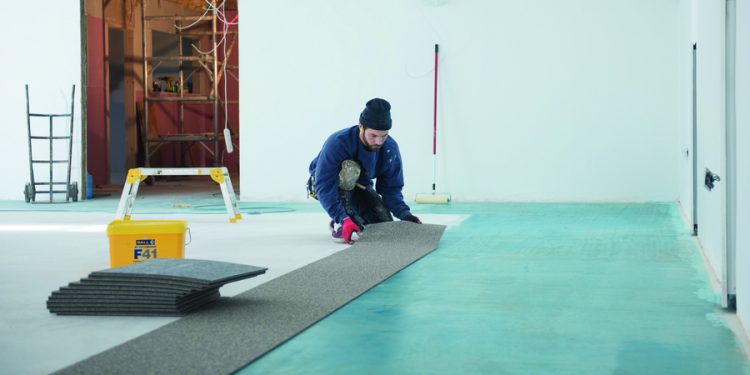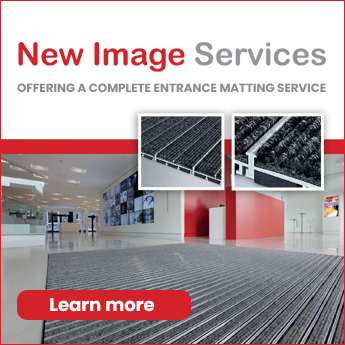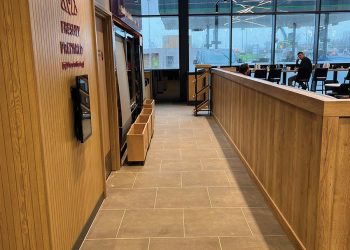HERE is a guide to high-performance adhesives for resilient and textile floorcovering and advice on selecting the optimum adhesive for a flooring installation.
The drive to help flooring contractors work to ever higher standards, with greater speed and efficiency, as well as increase the longevity of flooring installations, has led to the development of high performance adhesives with a range of specialist properties.
For this reason, when it comes to selecting an adhesive for a specific installation, it is always advisable to consider products that have been developed for particular applications and types of floorcoverings.
Adhesive selection should be based on the details of an individual flooring installation, including the properties required for ease of installation and the conditions to which the adhesive will be exposed. It is always advisable that contractors check the compatibility of adhesives and particular floorcoverings to ensure against floor failure.

Vinyl floorcoverings
Flooring contractors installing vinyl floorcoverings face a potentially confusing array of adhesives to choose from. Standard, wet-lay adhesives are available for installing almost any type of vinyl sheet or tile floorcovering. The contractor applies the adhesive evenly over the subfloor using a ‘V’ notched trowel and allows it to paste slightly before placing the floorcoverings and rolling to ensure good overall contact. This category includes F. Ball’s Styccobond F44 solvent free acrylic emulsion adhesive, which offers high bond strength, strong initial grab and a long open time.
Vinyl adhesives are also available with a range of additional features, including pressure sensitive characteristics, temperature tolerance and moisture resistance.
While wet-lay adhesives are fine where an immediate bond is not required, pressure sensitive adhesives are often the best choice for installing vinyl tiles or planks. When dry they form an instant grab upon contact, so contractors don’t need to worry about tiles or planks moving about when they are working, making them ideal for where intricate designs or patterns are being created.


Fast-track formulations
F. Ball’s recently launched Styccobond F58 PLUS is a fast-drying, fibre-reinforced, pressure sensitive adhesive that is ideal for the installation of Luxury Vinyl Tiles (LVT) floorcoverings. Its fast-drying formulation enables LVTs to be secured from just five minutes following application of the adhesive, allowing for a much speedier installation time.
Developed as a ‘transitional’ adhesive, Styccobond F58 PLUS transitions from a wet-lay adhesive when initially applied to a subfloor, through a semi-wet stage to become fully pressure sensitive. The reinforcing fibres in the formulation provide resistance to lateral movement, holding tiles firmly in place and reducing the potential for them to slide around.
The product’s extended open time of around three hours, when used as a pressure-sensitive adhesive (depending on ambient conditions), allows large areas of adhesive to be applied in one application without risking late placement of the floorcovering.

Temperature tolerance
Extreme temperatures and temperature fluctuations cause vinyl floorcoverings to expand and contract significantly, which can lead to unsightly tenting and gapping at the edge of floorcoverings, particularly vinyl tiles or planks, over time. This is often the case in conservatories or rooms with floor-to-ceiling windows, which are subject to ‘solar gain’.
For this reason, temperature tolerant adhesives have been developed for installing resilient floorcoverings in areas where temperatures have the potential to rise significantly. These kinds of adhesives hold floorcoverings firmly in place, restricting movement and ensuring the long-lasting performance of installations.
F. Ball’s Styccobond F48 PLUS, for example, is a fibre-reinforced high temperature grade adhesive for installing a range of vinyl floorcoverings. Again, fibres in Styccobond F48 PLUS allow it to offer high initial grab to hold floorcoverings securely in place while contractors are working. It is also fast drying, and as a one-part solution, there is no mixing required before application.
Moisture resistance
When installing flooring in an area subject to high levels of surface humidity and water, an adhesive with water resistant properties is essential. Without such properties, an adhesive may break down and soften when it comes into contact with water, potentially causing floorcoverings to bubble or de-bond.
Epoxy or polyurethane-based adhesives have long been the only option for such installations. These adhesives are highly effective at making areas impermeable to water, so they are also suitable for installing resilient floorcoverings outdoors where surface water may collect.
The latest advancements in adhesives technology have enabled
F. Ball to create a one-part, moisture-curing alternative for internal and external heavy-duty applications, which is also solvent and isocyanate free: Styccobond F73 PLUS.
This adhesive has been specially developed to provide the high bond strength required to hold a wide range of floorcoverings in place in the most demanding environments, such as in areas subject to surface water, heavy loads and high foot traffic, including in transitional areas and entranceways. Unlike reactive adhesives, it offers high initial grab, and fibres in the adhesive limit lateral movement of floorcoverings while contractors are working.
Styccobond F73 PLUS is also easier to apply and faster curing than traditional alternatives, requiring as little as 90 minutes to secure floorcoverings, and its fast setting properties allow for the welding of sheet floorcoverings to take place from as little as two hours.
Hybrid adhesives
The arrival of hybrid adhesives, such as F. Ball’s Styccobond F49 Hybrid PS, provides another solution for installing resilient floorcoverings in damp and humid environments. As well as being resistant to water, Styccobond F49 offers the familiar characteristics of pressure sensitive adhesives, making it ideal for installing LVTs in these settings. The water-based adhesive develops the extremely high bond strength to hold floorcoverings in place in areas exposed to extreme temperature fluctuations.
Styccobond F49 has also been approved by leading manufacturers for installing vertical flooring accessories, such as skirting, capping and coving. This means it offers an alternative to contact adhesives and allows contractors to use one adhesive to install both floorcoverings and accessories. Unlike contact adhesives, this hybrid adhesive only needs to be applied to one surface and provides high initial tack while allowing contractors to reposition floorcoverings and vertical accessories in the initial stages of drying.
Rubber floorcoverings
Rubber floorcoverings are a popular choice for schools, sports settings and even ships because they are durable, easy to clean and maintain, plus offer good grip in wet conditions. The strong initial tack and high bond strength of specialist rubber floorcovering adhesives make them ideal for securing a wide range of rubber sheet and tile floorcoverings. Such adhesives have a high film strength to provide good dimensional stability and prevent the rubber floorcovering from moving when subject to heavy traffic.
When used as a wet-lay adhesive, F. Ball’s new Styccobond F58 PLUS is ideal for the installation of rubber sheet and tile floor coverings up to 2.5mm thick. It is also MED certified in accordance with IMO standards for use in marine flooring projects.
Rubber floorcoverings are also regularly used for outside flooring installations because of their durability. In these situations, F. Ball’s alternative to traditional epoxy and polyurethane adhesives for heavy-duty environments, Styccobond F73 PLUS, can be used to make installations impervious to surface water.

Linoleum
When working with linoleum floorcoverings, F. Ball recommends the use of an adhesive that provides high initial grab and has been specially designed to adhere linoleum.
To be able to adhere hessian-backed linoleum floorcoverings, an adhesive must be able to ‘wet out’ the backing (i.e. transfer enough adhesive to create a good bond and deliver the instant grab that reduces the sliding of the linoleum when being installed). Specialist non-flammable, acrylic emulsion adhesives for linoleum floorcoverings include F. Ball’s Styccobond F54, which is solvent-free, protected against bio-degradation and suitable for use over normal underfloor heating systems.
Textile floorcoverings
F. Ball’s Styccobond F3 is a water-based rubber/resin flooring adhesive, which is suitable for installing a wide range of textile floorcoverings, including hessian, felt, secondary latex and rubber foam backed carpets, as well as cork tiles up to 3.2mm thick. Over 50 years since its original launch, Styccobond F3 is still the UK’s most used adhesive for textile floorcoverings.
The adhesive offers excellent wet grab, rapidly builds up a high bond strength and is protected against bio-degradation. It is also suitable for use over normal underfloor heating systems and approved for use in marine flooring installations.
Dual bond systems
When installing carpet over large areas that will be subject to heavy use, such as hotel corridors and events venues, contractors will typically require an adhesive such as Styccobond F3, which will develop a high bond strength to hold floorcoverings firmly in place over the lifetime of an installation. However, carpet and underlay installed with this kind of adhesive will require mechanical removal when they need replacing.
For this reason, dual-bond systems have been developed, utilising adhesives with different characteristics, including ones designed to create a peelable bond to prevent floorcoverings or underlay moving laterally when subject to normal foot traffic but allow them to be easily lifted without damaging the subfloor.
F. Ball’s Styccobond F40, for example, dries to form a transparent, permanently tacky coating to provide a release bond for underlays. This can be part of a dual-bond system, whereby the carpet is then adhered to the underlay using Styccobond F3, which will develop the high bond strength required to withstand expected levels of wear.

Carpet tile tackifiers
Loose-lay carpet tiles are often specified in schools, offices and other commercial premises because they can be individually lifted and replaced if they become damaged, worn or stained, an advantage in offices with chairs on castors or busy walkways, for example.
For this to be possible, flooring contractors will need to install the carpet tiles with a carpet tile tackifier that does not create a permanent bond, such as F. Ball’s Styccobond F41. Carpet tile tackifiers ensure that carpet tiles are held firmly in place when subject to lateral movements, including everyday foot traffic and equipment being wheeled around, while allowing them to be easily lifted vertically if they need to be replaced at a later date.
To use a carpet tile tackifier, contractors simply apply the adhesive evenly across the entire subfloor, using a roller or a brush, and allow it to dry to a clear, tacky film. The adhesive will then remain permanently tacky, enabling individual tiles to be easily adhered and removed.
Some carpet tile tackifiers, including Styccobond F41, are solvent free and, as testament to its ultra-low VOC emissions, it is certified EMICODE EC1 Plus, making it safe for use in enclosed or poorly ventilated area.
Compatibility check
Finally, it is highly recommended that contractors always check the compatibility of particular floorcoverings and adhesives. To do this, you can consult the floorcovering manufacturer’s guidelines. Alternatively, F. Ball produces a Recommended Adhesives Guide (RAG®), which lists adhesives recommended for use with over 6,000 floorcoverings produced by over 200 manufacturers.
Recommendations are included in the guide only after the completion of a rigorous seven-week testing programme at F. Ball’s state-of-the-art testing facilities and subject to endorsement by the relevant floorcovering manufacturer. This makes the F. Ball RAG® the most trusted and comprehensive guide to floorcovering-adhesive compatibility available.
So confident is F. Ball in the recommendations featured in the RAG® that it guarantees the resulting bond performance for the entire lifetime of the flooring installation, as long as the advised subfloor preparation and installation procedures are followed.
A constantly updated version of the RAG® is available on the F. Ball website and as a mobile app, which is free to download from the Apple App store or Google Play, allowing contractors to consult the trusted guide for advice on floorcovering-adhesive compatibility via the smartphone in their pocket at any time.
The guide is also available as a printed A5 booklet; free copies of which can be requested by e-mailing mail@f-ball.co.uk or calling 01538 361633.
F Ball & Co
01538 361633
mail@f-ball.co.uk
www.f-ball.co.uk












